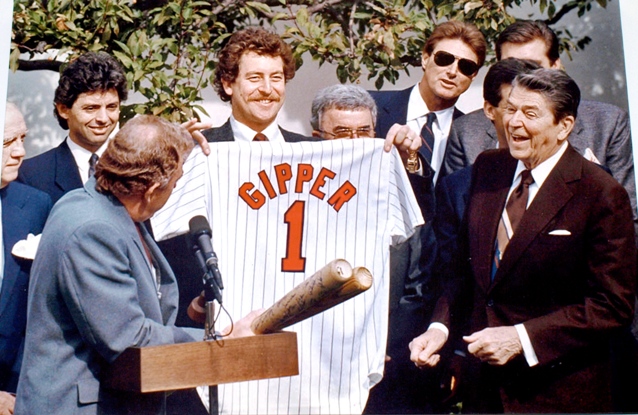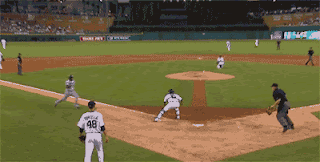![]()
![]() HE hope I dreamed of was a dream, Was but a dream;
HE hope I dreamed of was a dream, Was but a dream; and now I wake
Exceeding comfortless, and worn, and old,
For a dream's sake.
- Christina Rossetti, "Mirage," 1879
This past Friday night, Minnesota Twins centerfielder
Joe Benson made a miraculous catch off the bat of
David Ortiz at the Red Sox new spring training home, Jet Blue Park in Ft. Meyers, FL. The sprinting, over-the-shoulder grab was mindful of the famous play
Willie Mays made in the 1954 World series.
For this fan, it was notable in two other ways:
it was made in the deep, centerfield "
triangle" area (see photo), which is a near duplicate of Boston's Fenway Park-famous for Twins fans as it was there that
Torii Hunter broke his ankle in the
same region (A. Gleeman photo) in a regular season game in 2005, thus ending the Twins post-season hopes.
Also, Benson's grab is similar to those made by another Twin player of recent vintage, possessing a comparable skillset:
Carlos Gomez. Benson at times makes you believe he could cover the entire outfield by himself with his speed and arm strength.
Like Gomez. The flip side: Benson is magnetically drawn to striking out like the murderous Jason was to girls in college sorority houses. Over his minor league career to date, he's whiffed an average of once every four trips to the plate (565 k's in 2,373 plate appearances (24%). Again,
very like Gomez....and we hope against hope that his fate, at age 24, doesn't become another mirage, a la Mr. Carlos "
Go-Go" Gomez.
![]() |
2008 Upper Deck card: behold,
bunting technique perfection |
The Twins famous trade of
Johan Santana on Feb. 2, 2008 netted them Gomez,
Kevin Mulvey,
Deolis Guerra, and
Phillip Humber. The Twins had been put in the unenviable position of paying a huge hunk of their payroll to Santana, who was destined for free agency after 2008-unless Minnesota unloaded him for the best possible offer. After multiple rumors of trade packages, smokescreens and bald-faced lies (probably) involving the Red Sox and Yankees, the only team left standing was the Mets. Brand, spankin' new Twins GM Billy Smith lost the staring match with the Mets. Now, five years on, it seems fair to judge that trade objectively.
Blogger
Parker Hageman put it well recently when he compared it to Jack trading the cash cow for the proverbial handful of beans. Put another way, the Twins traded their precious ace without getting the best prospect in the Mets system (at that time, OF
Fernando Martinez) or a player from their 40-man roster (
Carlos Beltran,
Jose Reyes or
David Wright, though none from that group were included in the public discussion). The best that could be said of this collection of sprouts was that "they had potential," But in March of 2008, it appeared the Twins had acquired a budding stud in center fielder Gomez. His arrival in Minnesota couldn't have been more opportune, as he was viewed as an obvious replacement for the popular Hunter
*, who had departed for Anaheim. His spring training that year showed flashes of brilliance, along with eccentric inconsistency.
*Along with Denard Span, who lost the centerfield battle in spring training...![]() |
was known to lock his bats in a closet
for not performing well, this isn't all that odd to me... |
Spring Training-2008Jim Souhan (Minneapolis Star-Trib.) recorded this take on Carlos in a
March 30, 2008 column.
"Ask a Twin about Gomez this spring, and the response would be a head shake and a giggle. When Justin Morneau stopped laughing, he said: "He is one of a kind. In so many ways. He can absolutely fly. He's the kind of athlete who comes along very rarely, with that speed and also having power.
"I don't think he quite knows how to use his power yet. He thinks he has to swing harder to hit it farther. Hopefully, he'll figure it out. His arm from the outfield is as good as I've ever seen, although he needs to be more accurate.
"He's a little out of control. He's 1,000 miles an hour. But when he comes to the plate, or gets on base, everybody watches."
Perhaps this passage from that same Souhan piece tells you everything you need to know about Carlos, both then and now:"The other day in spring camp, Gomez was standing by the batting cage, waiting to hit, when someone lined a shot off the pitching screen. The ball shot back over the cage toward the backstop. Gomez took off on a dead sprint, executed a Willie Mays basket catch and held up the ball like a trophy. It was stunning and rather silly. No other player would think of doing that, and few could pull it off."
In 2008, at age 22, this is what the St. Bernard-like Gomez did in center field for the Twins:
| Year | G | Inn | Ch | PO | A | E | DP | Fld% | Rtot | Rdrs | RF/9 | RF/G | lgFld% | lgRF9 | lgRFG |
|---|
| 2008 | 151 | 1271.2 | 453 | 436 | 9 | 8 | 4 | .982 | 8 | 17 | 3.15 | 2.95 | .989 | 2.71 | 2.69 |
In summary, here's how he stacked up to the other CF's in the American League:
- First in putouts (54 more than Grady Sizemore, in same number of games)
- First in range factor (RF/9) 3.15, with next closest: Rajai Davis, 2.92
- First in games played as a center fielder, 151 (tied with Sizemore)
- AND...first in errors as a center fielder, 8, tying with Delmon Young among outfielders
We're it not for his strong, yet innaccurate arm, Gomez could have been a hands-down Gold Glove winner, an obvious star-in-the-making. He certainly didn't lack charm for the role:
A fine, 4 for 5 night at the plate made this a memorable evening during the 2008 season. So, you see, it wasn't just his eccentricities, and
fear of ghosts (see June, '08 Patrick Reusse column) that drew people to him. In small doses, he made you
believe. Sorry to dredge up Telly Hughes, the King of the Cliches, for you Twins fans!
July 26, 2009: just another day at the office for Carlos!
WARNING: for some reason, MLB videos seem to run in a loop - will need to pause the two here!
July 27, 2009 outfield injury - watch Gomez' pinwheeling, dazed, fall at the :57 mark. Carlos had mishaps, i.e, running into the centerfield wall, which gave the impression he'd been shot by a sniper. To wit: there's a vaguely Michael Richards "Kramer" aspect about this...
It has long been expressed that Gomez, if he were to concentrate on better plate coverage, he could emerge as a middle of the order hitter ("Lay off those outside pitches, ya big dummy!"). Again, it has never been a question of physical talent with him, blessed by The Baseball Gods with an insane gob of natural ability. The tantalizing thought of what he could be if he were to reign in his undisciplined nature, and make the neccessary physical adjustments has vexed 3 organizations by now. Like the aforementioned Mr. Benson, he's a wind turbine, striking out 377 times in 1,678 lifetime Major League PA's - or,
22% of the time. The Twins, exasperated by Gomez' flailing, traded him to Milwaukee on Nov. 6, 2009 for shortstop
J.J. Hardy (a subject I will tackle once I can gain the courage to do so).
![]() |
Carlos Gomez scores winning run, Game 163, Oct. 6, 2009.
The win propelled the Twins to the ALDS against New York.
(AP Photo) |
Jack Moore in his article "
Should Carlos Gomez Stand Closer To The Plate?" at the
Disciples of Uecker" blog addresses a fine tuning for 2012 that could be of help. Jack's opinion as a Brewers fan and baseball mind should be given credence. At this point in his career, however, I would be hard pressed to see Carlos changing his approach with any kind of diligence.
He has the same problem
Bobby Bonds (Sr.) had, and far worse: loads of offensive potential that is offset by poor pitch selection, and striking out way too much - thus negating his otherwise stellar contributions. He is a liability, therefore, to his team. Jonathan Ede piece in
Media Milwaukee on March 18, 2012, concludes it is time for the Brewers to cut the cord with Carlos. I must say, he's persuasive, especially in light of the fact his comments mirror precisely the things said about the same player four springs ago. Like a lot of fans, I was a fan of his then, and I still am, with my ardent wish being he will one day turn the corner. How could you not root for a guy who left winter ball to be at the bedside of his son,
afflicted with meningitis?
But then, most of us know what
Burgess Meredith had to say about wishing...but I can still dream.
As our old broadcasting friend Herb Carneal closed his postgame shows:
"
So long, everybody!" - TT














































